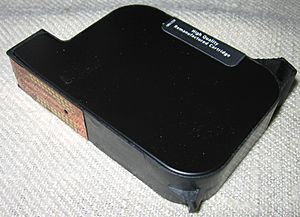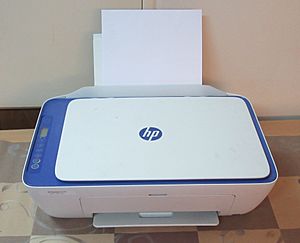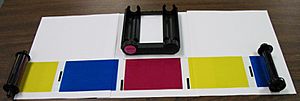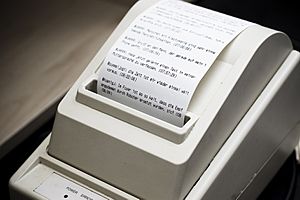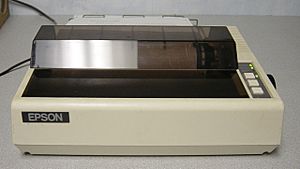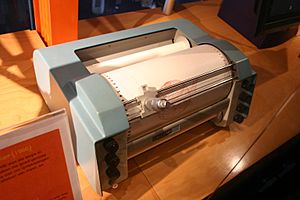Printer (computing) facts for kids
A printer is a machine that takes information from a computer and puts it onto paper. It can print words, pictures, or even special codes like barcodes. Think of it like a digital artist that draws or writes whatever you tell it to, usually on paper.
Contents
History of Printers
The idea for a computer printer goes way back to the 1800s! A scientist named Charles Babbage designed one for his special calculating machine, but it wasn't actually built until the year 2000.
The first real step towards modern printers was in 1962. That's when C. R. Winston invented a way to spray ink onto paper using electricity. This led to the Teletype Inktronic Printer, which came out in 1966.
Then, in 1968, a Japanese company called Epson created the EP-101, which was the first small, light digital printer.
In the early days, computer printers often used parts from electric typewriters or Teletype machines. But people wanted faster ways to print! So, new types of printers were made. In the 1980s, there were:
- Daisy wheel printers: These were like typewriters and printed very clear text.
- Line printers: These printed whole lines of text super fast.
- Dot-matrix printers: These could print both text and simple pictures, but the quality wasn't always the best.
- Plotters: These were used for drawing high-quality lines, like for blueprints.
A big change happened in 1984 when the first HP LaserJet printer came out. It was a laser printer and made printing much cheaper and better quality. Soon after, the Apple LaserWriter added something called PostScript, which made it easy to mix text and graphics. This started the "desktop publishing" revolution, where people could create professional-looking documents right from their personal computers.
In 1988, the HP Deskjet brought inkjet printers to the market. These could also print text and graphics, and they were much cheaper than laser printers. Soon, inkjet printers became very popular and replaced older dot-matrix and daisy-wheel printers. By the 2000s, good quality printers cost less than $100 and were found in many homes.
Even though internet and email made it easier to share documents without printing, a new kind of printer became popular around 2010: the 3D printer. These amazing machines can create real, physical objects layer by layer, almost like a laser printer prints on paper. Today, 3D printing is a popular hobby, with many affordable kits available.
Types of Printers
Printers come in different types, each designed for specific jobs.
Personal Printers
These printers are made for one person to use, usually connected to a single computer. They are good for printing small amounts of documents quickly, like homework or a few photos. They might be slower (6 to 25 pages per minute) and cost more per page, but they are very convenient for home use. Some can even print directly from memory cards or digital cameras.
Networked Printers
These are big, fast printers designed for many people to share on a network, like in an office or school. They can print very quickly, from 45 to over 100 pages per minute, and are built for printing large amounts of documents.
Virtual Printers
A virtual printer isn't a real machine you can touch. It's a computer program that acts like a printer. Instead of printing on paper, it creates a file (like a PDF) that you can save, email, or use with another program.
Barcode Printers
These special printers are used to create barcode labels or tags. You often see them in stores for UPC codes on products, or in warehouses for shipping labels.
3D Printers
A 3D printer builds a three-dimensional object from a digital design. It adds layers of material (like plastic, metal, or even food!) one on top of the other until the object is complete. It's called a printer because it works similarly to how an inkjet printer puts layers of ink on paper.
ID Card Printers
A card printer is a special desktop printer that prints on and personalizes plastic cards. These are the cards you use every day, like credit cards, driver's licenses, or school ID cards. They usually print on cards that are the same size as a bank card.
The way they work is pretty cool: a plastic card goes through a hot print head at the same time as a colored ribbon. The heat transfers the color from the ribbon onto the card. This process can create very detailed images.
There are different ways these printers work:
- Thermal transfer: This is often used for simple, single-color printing on cards that already have some design.
- Dye sublimation: This method uses four color layers (CMYK) to create full-color images with millions of shades. A clear protective layer is added afterward to make the card last longer.
- Reverse image technology: This is used for high-security cards. The image is printed onto a special film first, and then the film is fused onto the card. This means the print head never touches the card directly, which is good for cards with chips or bumps.
- Thermal rewrite: These cards can be printed, erased, and printed again! They are often used for student ID cards that change each semester.
Card printers can also do more than just print. They can read and write information onto magnetic stripes or smart chips on the cards. This allows them to create cards that work for things like access control or electronic payments.
People use ID card printers for many things, such as:
- Employee or student ID cards
- Customer loyalty cards
- Sports tickets
- Public transport passes
- National ID cards
How Printers Work (Technology)
The way a printer works affects how much it costs, how fast it prints, the quality of the print, and even how loud it is.
Modern Print Technologies
Here are the main types of printers you'll find today:
Toner-based Printers
Laser printers are very common and print high-quality text and graphics quickly. They use a special powder called toner and a laser to create the image on paper. LED printers are similar but use tiny lights instead of a laser.
Liquid Inkjet Printers
Inkjet printers work by spraying tiny drops of liquid ink onto the page. They are the most popular type of printer for home users because they can print both text and colorful pictures.
Solid Ink Printers
Solid ink printers use solid sticks of ink, like crayons. These sticks are melted, and the liquid ink is sprayed onto a drum, then transferred to the paper. They are great for color printing, especially on clear sheets. Xerox is the main company that makes these printers. They produce excellent results but take a while to warm up.
Dye-sublimation Printers
A dye-sublimation printer uses heat to transfer dye from a ribbon onto paper or plastic. They are mostly used for printing high-quality color photos, making prints that look like they came from a photo lab.
Thermal Printers
Thermal printers use special heat-sensitive paper. When heated in certain spots, the paper changes color, creating the image. You often see these in cash registers, ATMs, and old fax machines.
Older and Special Printers
Some older printer types are not as common today, but they were important in the past or are used for very specific tasks.
Impact Printers
Impact printers work by hitting an ink ribbon against the paper, much like a typewriter. They make a lot of noise!
- Dot-matrix printers: These use a grid of small pins to create letters and pictures. They can print on special multi-part forms (like carbon copies) and are still used in some businesses for things like invoices or receipts.
- Line printers: These were very fast printers that printed a whole line of text at once. They were used in large computer centers but have mostly been replaced by fast laser printers.
Plotters
Pen-based plotters use pens that move across the paper to draw lines. Engineers and architects used them to create very detailed drawings and blueprints, often on very large sheets of paper.
Printer Features
How Printers Connect
Printers can connect to computers in many ways:
- Directly with a USB cable.
- Wirelessly using Bluetooth (for short distances) or WiFi (for networks).
- Some can even work by themselves, printing from a memory card or other storage device.
Printer Languages
Printers need special instructions to know what to print and how to print it. These instructions are given using "printer control languages" or "page description languages" (PDLs). Common ones include PCL and PostScript. These languages tell the printer things like what font to use, how big the text should be, and where to place images.
Printing Speed
Printer speed used to be measured in "characters per minute" (cpm) or "lines per minute" (lpm). Today, most printers are measured in "pages per minute" (ppm). Keep in mind that these speeds are usually for simple black-and-white documents; printing colorful pictures takes much longer.
Monochrome, Color, and Photo Printers
- A monochrome printer prints only in black and white (or shades of one color).
- A color printer can print in many colors.
- A photo printer is a special color printer that can make prints that look just like photos from a camera.
Page Yield
Page yield tells you how many pages a toner cartridge or ink cartridge can print before it runs out. This helps you compare how long different cartridges will last.
Printer Costs
Printers often follow a ""razor and blades"" business model. This means the printer itself might be sold cheaply, but the company makes its profit from selling the ink cartridges or toner, which you need to buy regularly. This is why compatible ink cartridges from other companies are sometimes much cheaper.
Hidden Printer Dots
Did you know that some color laser printers add tiny, almost invisible yellow dots to every page they print? This is a type of steganography (hiding data within data). These dots contain coded information like the printer's serial number and the date and time the page was printed. This can be used to track where a document came from.
See also
 In Spanish: Impresora para niños
In Spanish: Impresora para niños
- 3D printing
- Dye-sublimation printer
- History of printing
- Label printer
- Printer driver
- Smart card


